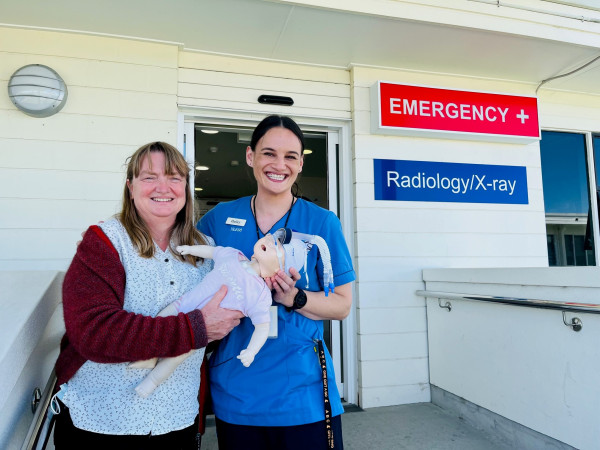Taupō Hospital leads the way with neonatal care
22/11/2023
Rural babies born struggling to breathe have a better chance of survival if a certain piece of kit is used, a Taupō Hospital study has found.
The Waikato Times reported on the study.
It's called bubble Continuous Positive Airway Pressure or b-CPAP and - unlike traditional neonatal breathing machines - doesn't require a nurse or doctor to stay and hold it in place.
While it's not often used in a rural emergency department, a nurse-led five-year study at Taupō Hospital showed advantages for babies who needed resuscitation, including fewer of them requiring helicopter transfers and admissions to high-level neonatal intensive care.
The study, titled The use of neonatal bubble Continuous Positive Airway Pressure (b-CPAP) in a rural hospital setting, was undertaken by Taupō Hospital's rural hospital medicine specialist Dr Glenn Barker and was published recently in the New Zealand Medical Journal.
The results found that while there were longer stays in ED for babies who required b-CPAP, the time applying assisted ventilation was significantly reduced from an average of 89 minutes down to an average of 47.5 minutes.
There was also an 11% reduction in the use of rescue helicopters to transfer at-risk babies to larger hospitals and an 18% reduction in admissions to regional level three neonatal intensive care units.
Barker concluded that the introduction of b-CPAP into a rural hospital setting was "technically feasible and results in less time spent on technically demanding hand ventilation, fewer admissions to level three neonatal intensive care units and a reduction in the use of aero-medical retrieval assets".
Taupō Hospital paediatrician Dr Belinda Coulter and staff nurse and clinical nurse educator Hailey Holmes have been instrumental in the study and have shown rural hospitals can provide similar neonatal care to their metropolitan colleagues.
"Any baby on bubble-CPAP is in trouble and will need to be moved, but this means we can give those babies the best care ...and we are able to free up a nurse because you don't have to have them standing there holding a mask on their face," Dr Coulter said.
B-CPAP machines deliver pressurised heated and blended oxygen to babies and provide far better results than traditional "T-piece" neonatal breathing machines but are usually used by paediatric staff, and not in ED.
"What the nurses have done in terms of implementing bubble-CPAP is like the icing on the cake of many changes that have happened to improve babies' well-being here," Coulter said.
She said having an ED and maternity ward co-located meant at-risk babies could receive the same level of care as if they were already in a secondary or tertiary hospital, such as Rotorua or Waikato, and be transferred appropriately.
"Many of them improve on bubble-CPAP ... and then we can assess whether they need to go to Rotorua in an ambulance, or Starship in a helicopter." Holmes said their team were now able to provide "best standard practice" for babies suffering from respiratory issues in a rural hospital setting.
"Starting them on bubble-CPAP here gives them the best possible chance.
"As far as I'm aware, this is the only ED utilising bubble-CPAP rurally," Holmes said.
"They (babies on b-CPAP) will always need to be transferred, but this means it's not guaranteed they need to have an air transfer and can instead go to Rotorua rather than all the way to Auckland or Waikato.
"We are very proud of what a small rural emergency department has done in the rollout and implementation of bubble-CPAP and the way that staff have taken to it." Waikato Hospital's head of newborn services Dr Jutta van den Boom said being able to provide babies with the appropriate respiratory support in their time of need while in a rural hospital was "especially important" as metropolitan hospitals were usually at capacity, "and every admission that can be cared for at the regional hospital is helpful".

An example of a baby needing care being placed on a bubble-CPAP machine, freeing up nurses to take on other jobs. Dr Belinda Coulter, left, and staff nurse Hailey Holmes helped study the use of bubble-CPAP machines for neonatal care in rural emergency departments.
